I bought a lightly used S&W 640-3 about four years ago. A friend’s elderly neighbor was thinning his collection and didn’t want his guns getting into the wrong hands. It was priced fairly, and I rationalized the purchase as an altruistic deed to help the man out.
magnum force
The 640 was S&W’s first J frame .357 Magnum. It’s a dependable, no frills compact revolver. The frame, barrel, and cylinder are constructed of stainless steel, the thumb piece, trigger, hammer, and some internal parts are MIM components. This one was made in 2006 and came with the very unpopular internal lock as standard equipment.
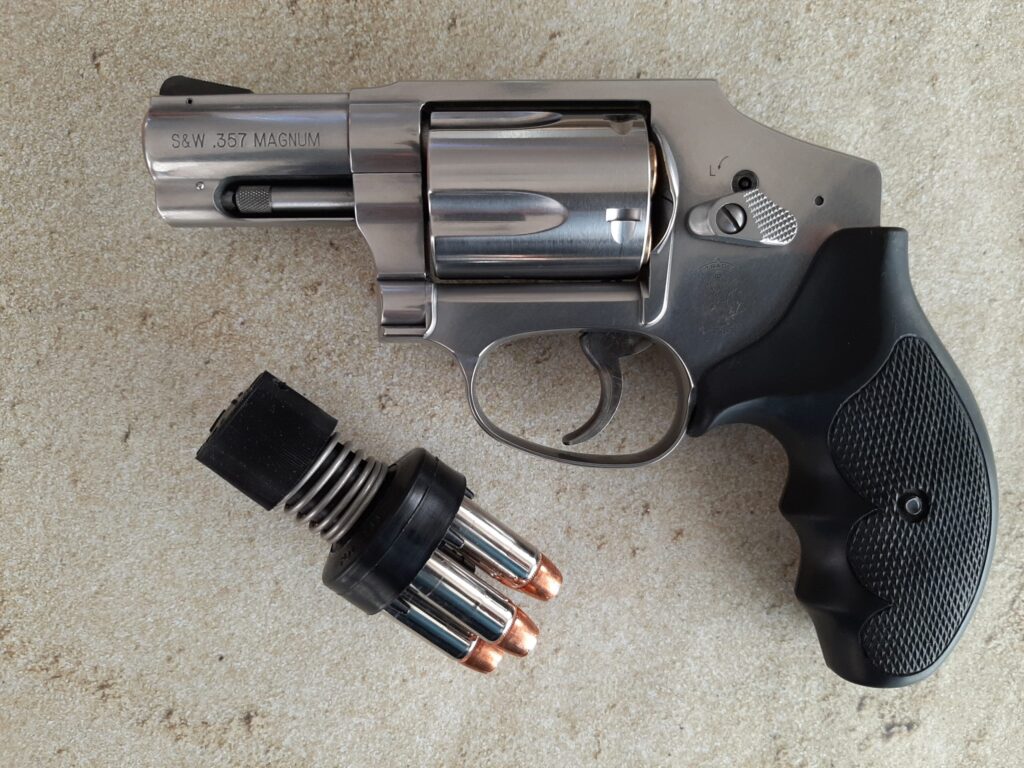
The barrel measures 2.125”, compared to the standard 1.875” J frame barrel. That allows a longer extractor rod that ejects spent casings more reliably than ones with shorter throw. The 640 has slightly better sights than most J frames—it has a pinned-in front sight (at least it’s black and serrated) to go with the milled trench rear. The rubber factory stocks completely enclose the backstrap and extend past the bottom of the frame about 1/2”.
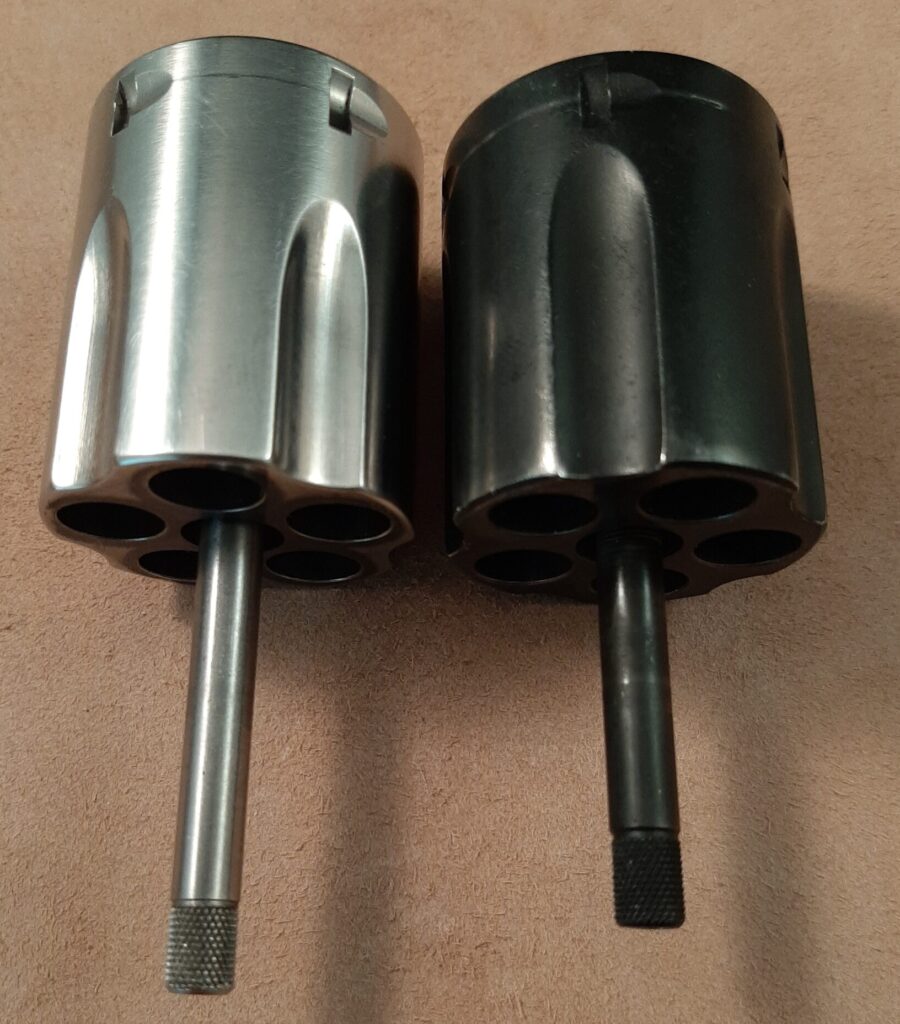
I wasn’t expecting much from it as a shooter. The trigger pull wasn’t great, and the sights didn’t mesh well with aging eyes for pinpoint shooting. It shot decently at 10 yards despite these handicaps. The 640 seems heavy for a J frame, until you start shooting .357 Magnums. I fired 20 mid-range .357’s through it, that was enough. Shot to shot recovery was slow, and my shooting hand developed a temporary tremble that turned into a few days’ worth of stiffness. The hard rubber stocks weren’t as forgiving as they looked. It’s nice to know you can, but shooting full house magnums in a J frame (even a solid steel one) is an activity to avoid. The 640’s weight makes it a “shoot all day” gun with .38 Specials, even +P’s. A middle ground between the .38 +P and the .357 Magnum would be the sweet spot in a gun this size and weight.
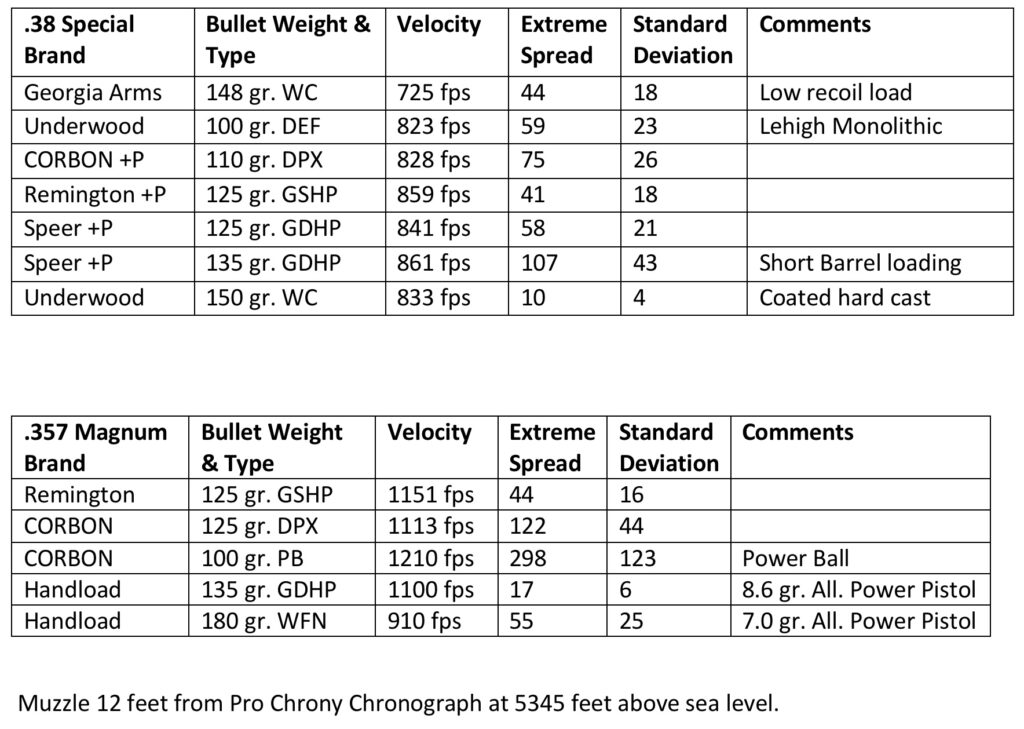
Metric system
Shooting a bunch of rounds through a S&W 547 and an RIA AL 9.0 convinced me of the efficiency of the 9mm cartridge in 3” barreled revolvers. While testing the AL 9.0, I ended up on TK Custom’s website to order moon clips for it. They sell lots of cool revolver stuff and offer gunsmithing services– including rechambering certain .38/.357 revolvers to 9mm or .38 Super. TK’s rechambering includes milling the cylinder for moon clip use and chamfering the charge holes (a mod that any revolver benefits from). The more I thought about it, the more converting the 640 made sense. Eli from TK was good to answer my questions and offered his input on the conversion. A few side jobs later, the 640 cylinder was headed to Illinois.
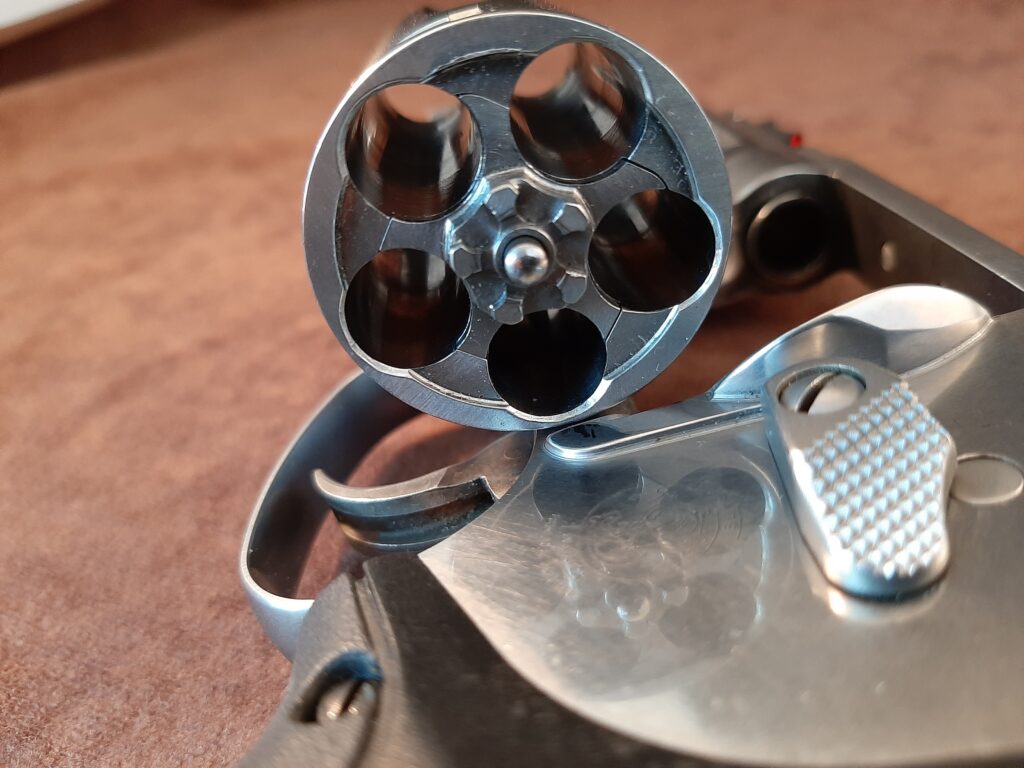
In addition to the ballistic edge the 9mm cartridge would likely provide, ammo availability was a big factor. For months, it was nearly impossible to find factory .38/.357 ammo because of the COVID scare and related “supply chain” issues. Even today, internet searches reveal ample 9mm choices, but slim pickings in .38, slimmer still in 357. Moon-clipped empties also give an extraction advantage over loose cases; They cannot lodge underneath the extractor star. The short cases exit the cylinder as a unit and give the best chance of drama free ejection if a reload is required.
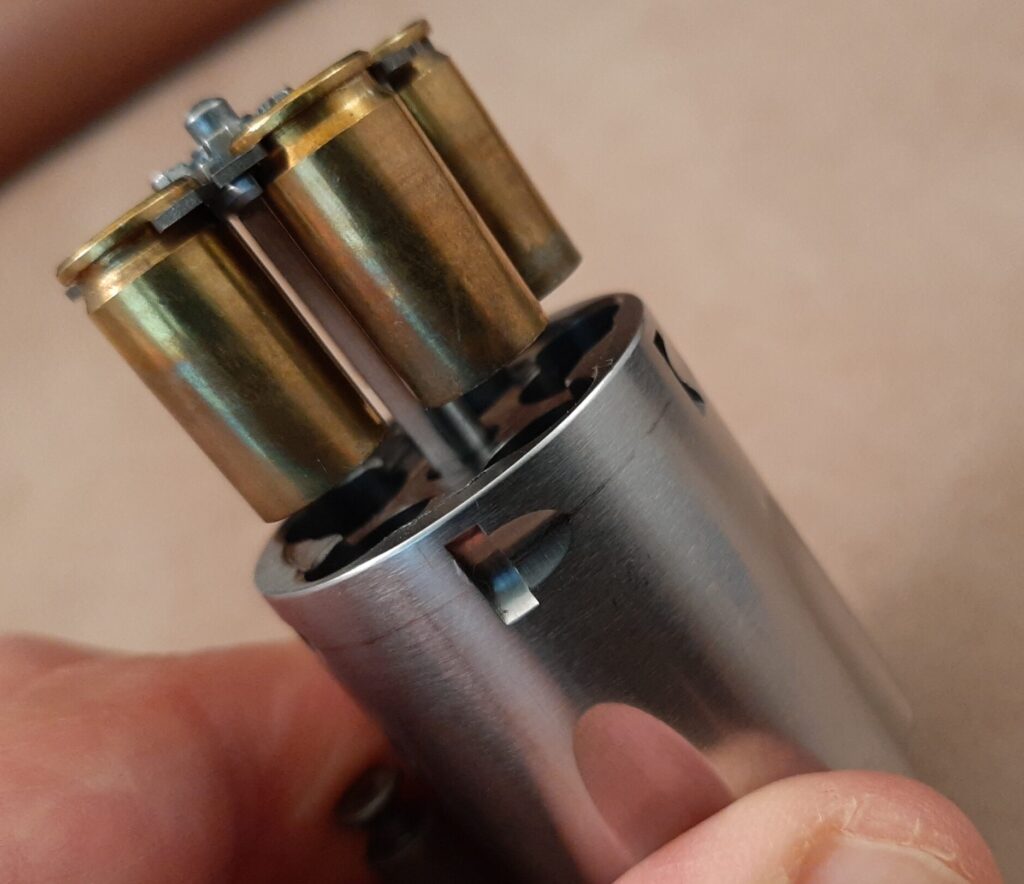
Shoot for the moon
In short order, TK had the converted cylinder back and I was spending range time with a large assortment of standard pressure 9mm ammo. I had worried that .355” diameter 9mm bullets wouldn’t shoot well in the slightly larger bore of the .357, my fears were unfounded. In most cases, the 9mm rounds shot on par with .38’s or .357 Magnums. One issue noted was 147 grain 9mm bullets didn’t seem to be stabilizing well and would occasionally hit paper off kilter. This wasn’t usually an issue with 135 grain and lighter 9mm bullets, and the 640 stabilized heavier .357”-.358” bullets fine.
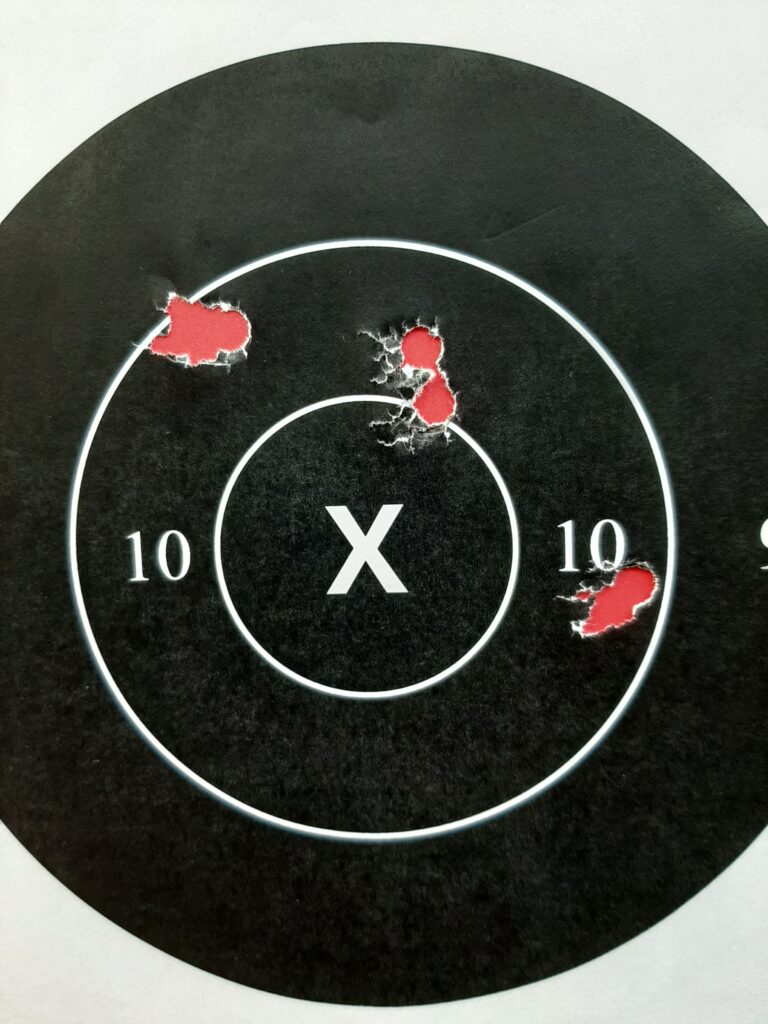
The closest I could come to an “apples to apples” ballistic comparison was Remington’s first-generation Golden Saber. The .357 Magnum 125 gr. GSHP averaged 1,151 fps, while the .38 +P 125 gr. version ran 859 fps. The 9mm 124 gr. Golden Saber measured 1,010 fps: it was pleasant to fire, ejected easily and shot to the sights. Accuracy was good despite velocities being a bit inconsistent. The 124 9mm load hit that “sweet spot” I was hoping for in the 640.
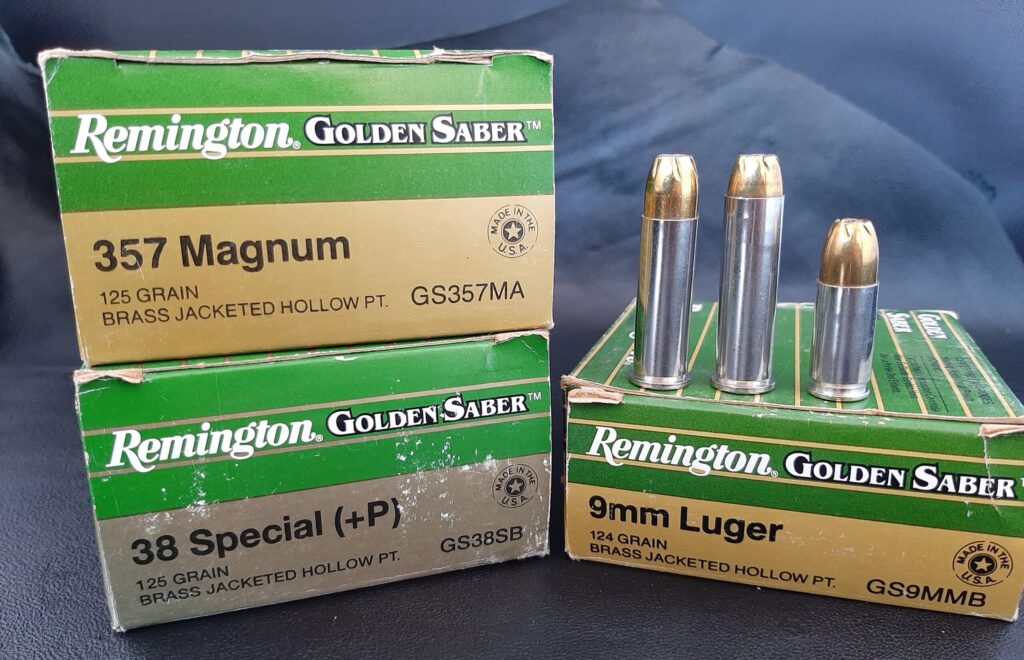
To date, I’ve tried twenty-seven different 9mm loads in the 640. Of those, one FMJ load and one JHP load wouldn’t chamber. Both would chamber in the AL 9.0, the 547, and ran fine in semi autos. SAAMI spec on the widest part of a 9mm case shoulder is .391”. Most cases measured around .385” at the widest point and chambered easily. The cases that wouldn’t chamber fully were very close to maximum chamber diameter: the FMJ at .389”, the JHP at .388”. TK’s chamber is cut very tight– my suspicion is that it must be to maintain proper function with .38/.357 rounds.
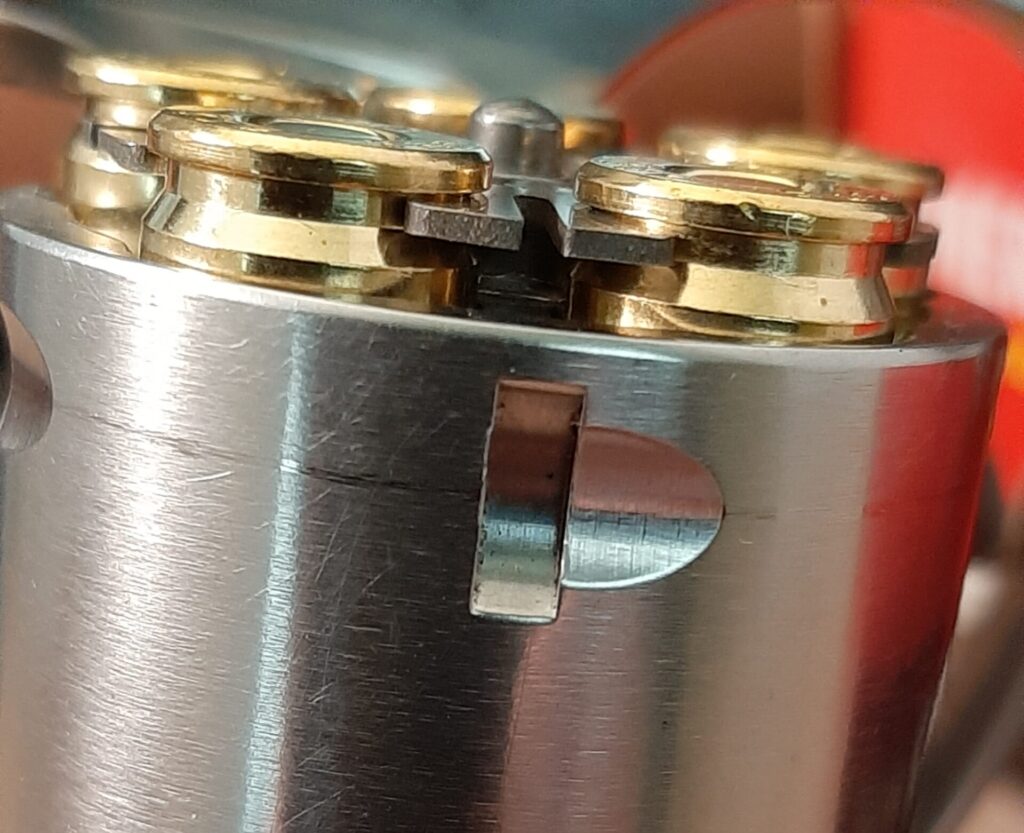
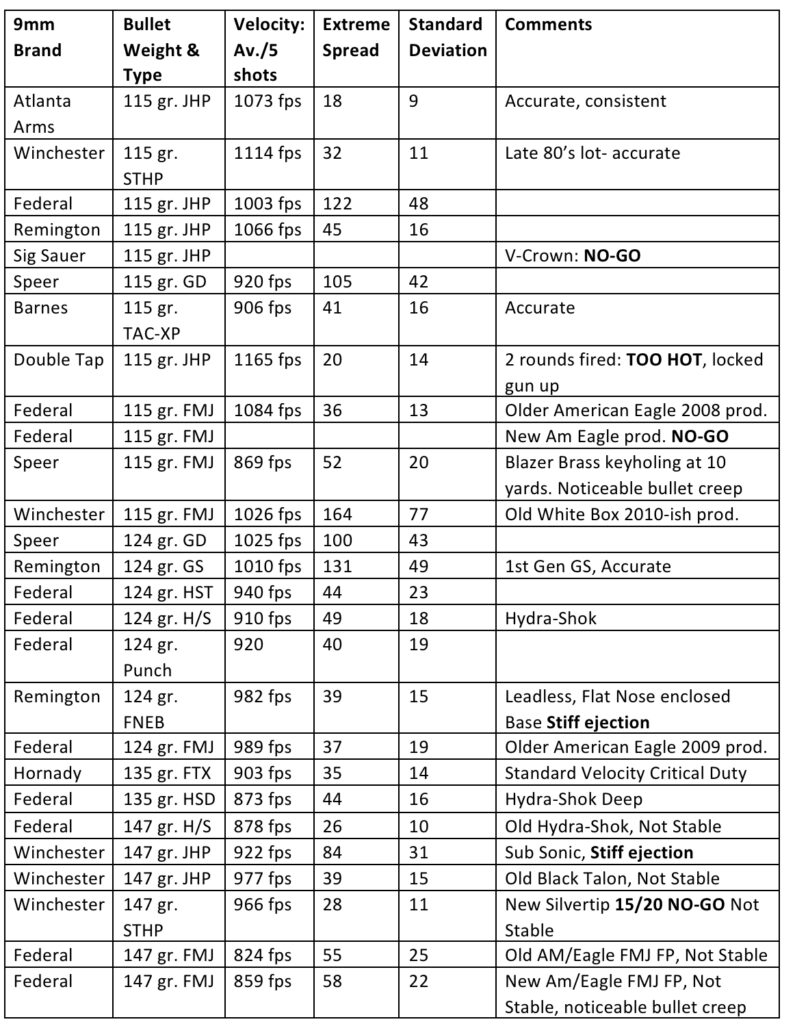
warnings
TK Custom is very clear that no +P, +P+, or 9mm NATO ammo should be used. The SAAMI spec for the 9mm cartridge is 35,000 PSI, same as the .357 Magnum. Higher pressure 9mm ammo can result in cases sticking in charge holes and failing to eject. I experienced that with a few rounds that swelled in the chambers enough to cause difficult ejection.
One round from Double Tap demonstrated why TK frowns on +P ammo. It was loaded with Hornady’s 115 gr. XTP bullet and rated at 1,170 fps from a 4.5” barrel. The first shot registered 1,175 fps on the chronograph on a cold day. The trigger wouldn’t budge for a second shot. It took significant effort to push the cylinder out, the extractor rod had to be tapped with the demooner tool to eject the rounds. The brass and primer looked normal, so (genius that I am) I tried again. Round #2 produced 1,155 fps and again completely locked up the gun. The ammo wasn’t designated as +P, but it must’ve been. The case pushed rearward upon firing and struck the recoil shield as the brass swelled and pinned the case back. This kept the cylinder from rotating, and after getting it open, prevented the brass from ejecting. Double Tap builds great ammo, this load was just too hot for this revolver.
no jumping allowed
Bullet jump wasn’t an issue with this gun. Its weight and the lack of recoil produced by standard pressure ammo minimized it. I would check periodically by firing four rounds and then inspecting the remaining round. There was some movement with practice rounds (especially 147 FMJ) but not enough to cause problems. There was no discernable creep with modern defensive ammunition loaded with 115 and 124 grain bullets.
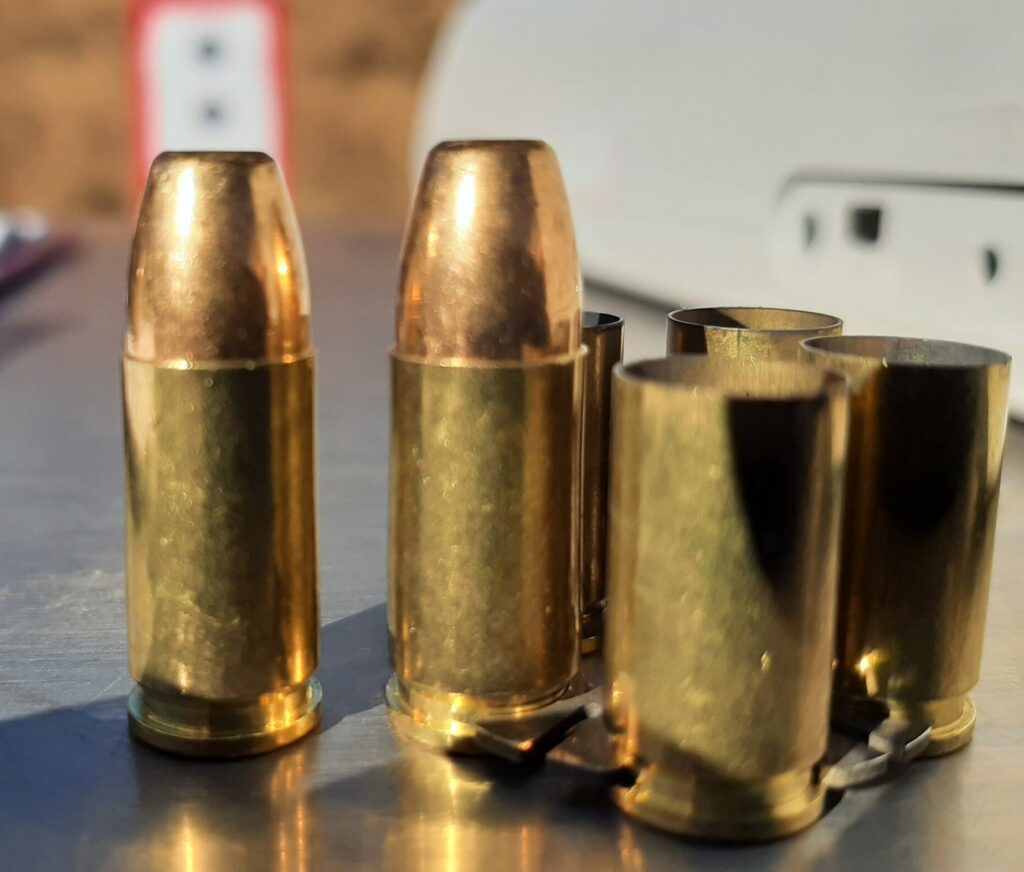
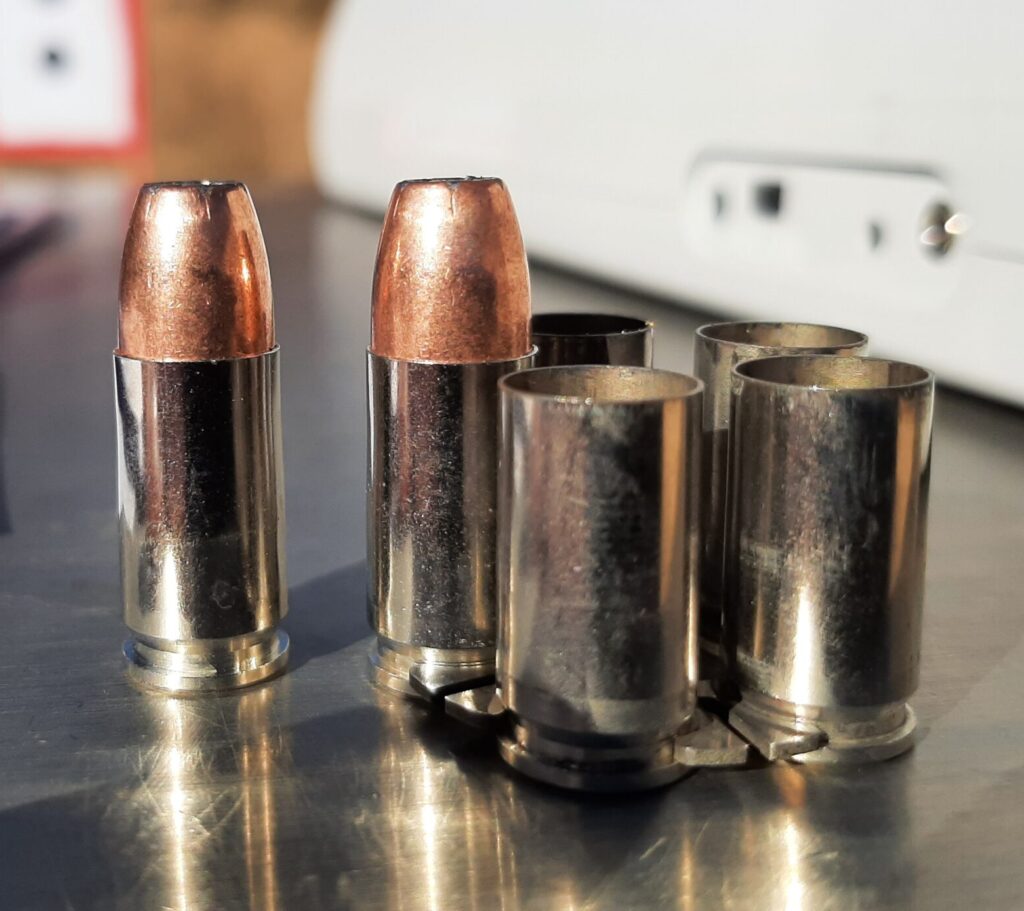
Blazer Brass 115 gr. FMJ would pull out of the case about 2mm by the fourth round. Its minimal crimp just doesn’t work well in revolvers. It was the only bullet of that weight that didn’t agree with the 640 and would sometimes keyhole at 10 yards– save it for semiautos.
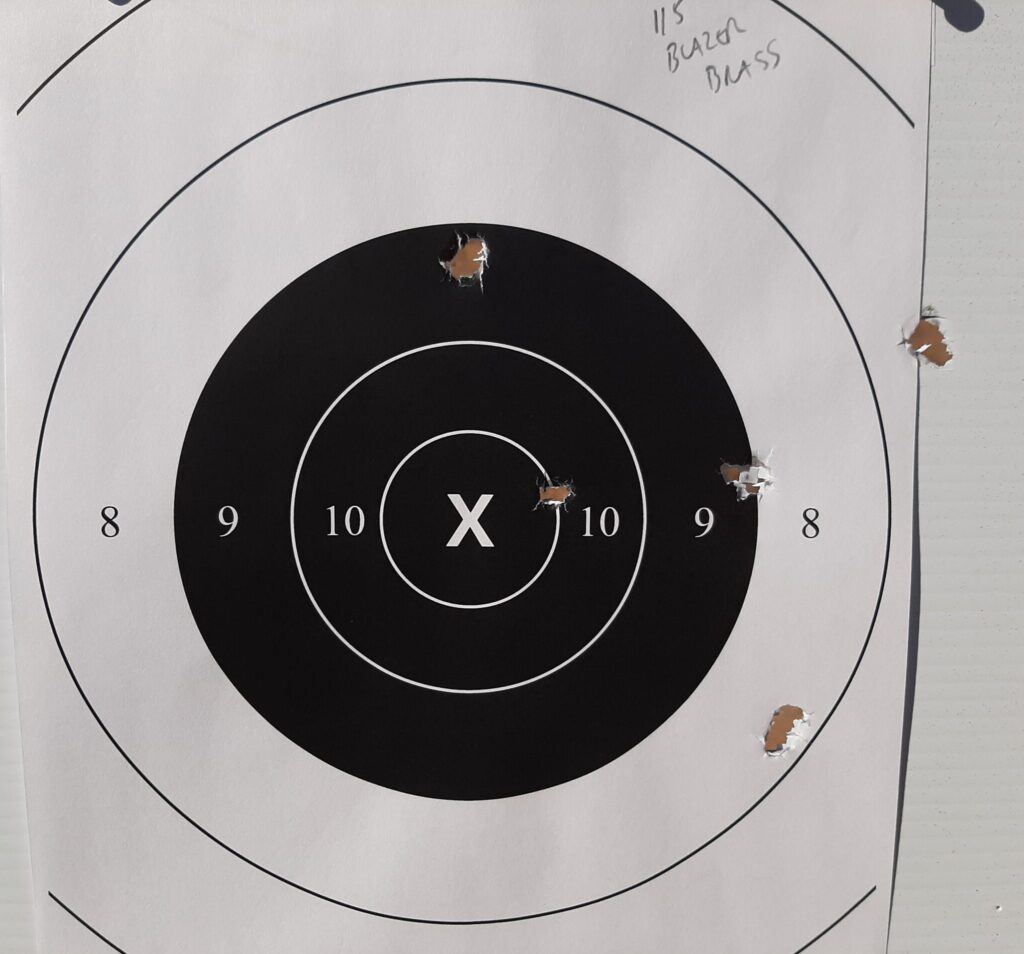
The 9mm at standard pressure outclassed factory .38 Special +P loads by a significant margin with lighter weight bullets. Of all the loads tested, old Winchester 115 grain Silvertips (late 80’s vintage) impressed the most. They averaged 1,110-1,120 fps with low extreme spreads regardless of the temperature (30-90 degrees). The Silvertip chambered and ejected easily and grouped well, hitting to the sights.
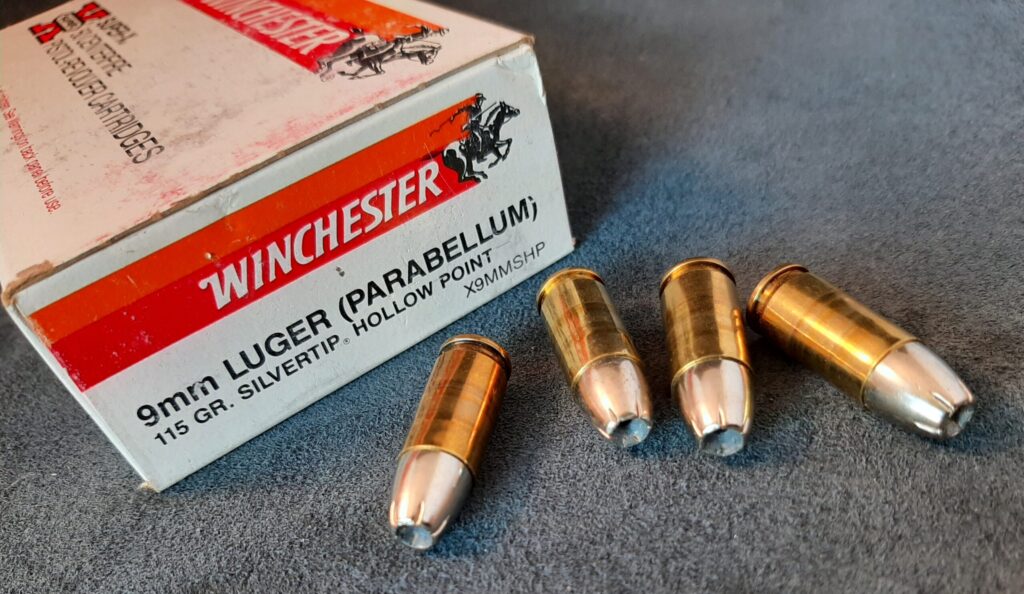
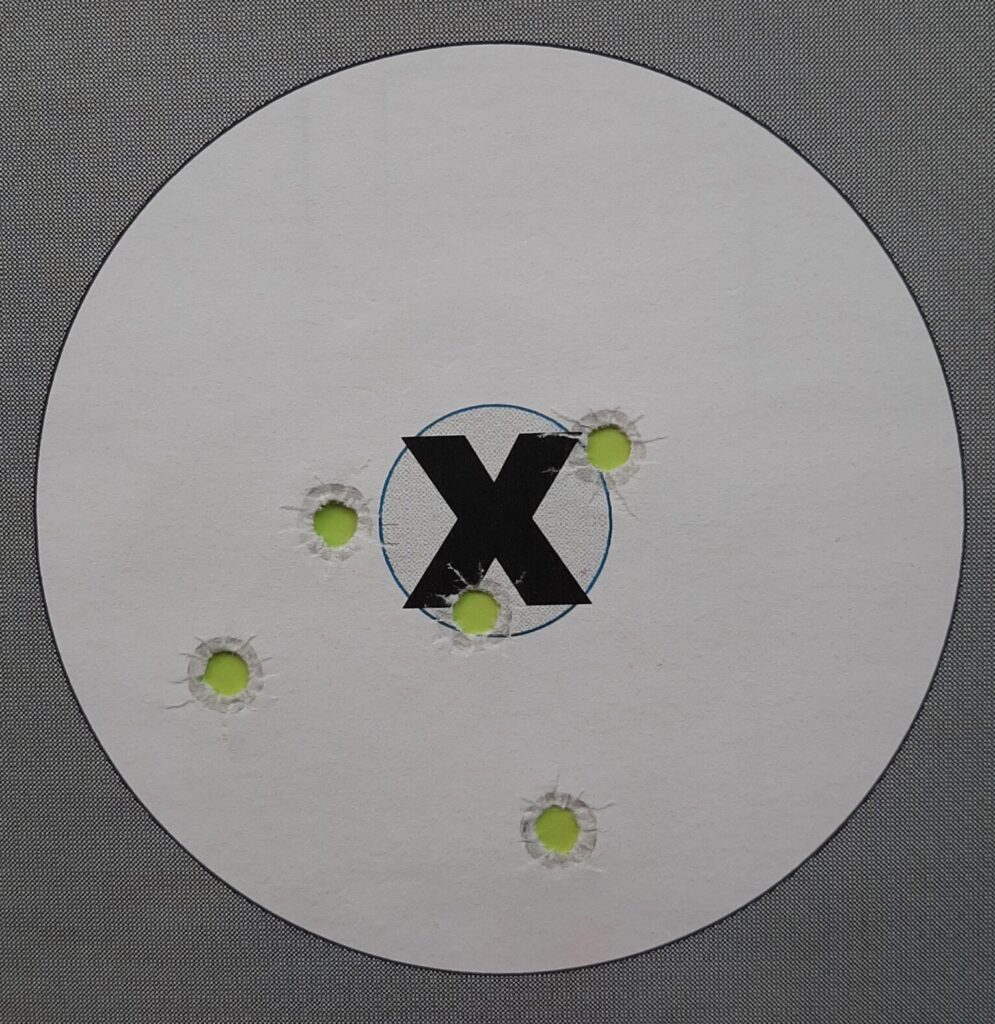
Atlanta Arms’ 115 gr. JHP was noteworthy for its high, consistent velocities and accuracy as well. Remington’s 124 gr. Golden Saber and Speer’s 124 gr. GDHP weren’t quite as consistent but would work for those preferring a more modern bullet. If I end up in the boonies with this gun, it shoots my “woods” handload well. A .357 180-grain cast WFN that runs 1,042 fps from a 4” Model 66 averages 910 fps from the 640. Heavy bullets with wide fronts don’t need to be supersonic to achieve needed penetration.
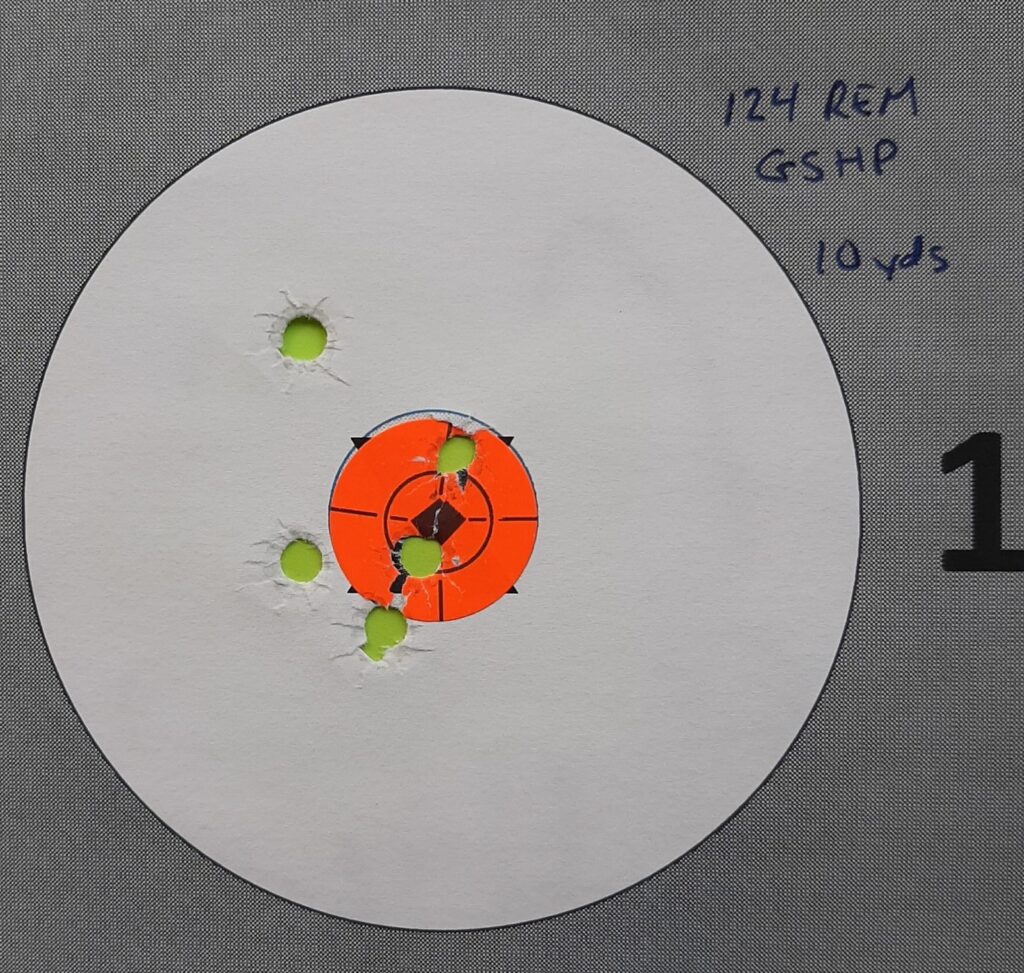
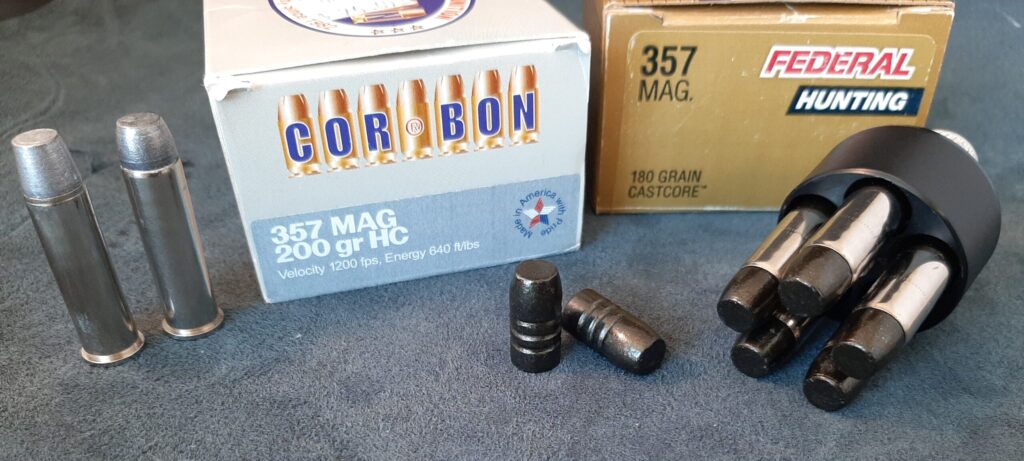
get a grip
Shooting .357 Magnums pre-conversion had convinced me that the 640 needed different stocks. Massad Ayoob recently wrote about equipping a S&W M&P 340 with Crimson Trace LG350-G laser grips to help with the light weight’s recoil. The LG350 offered more width and cushion behind the gun’s frame than the LG405 “boot grip” that I was familiar with, and the green laser was allegedly visible in more lighting conditions than red.
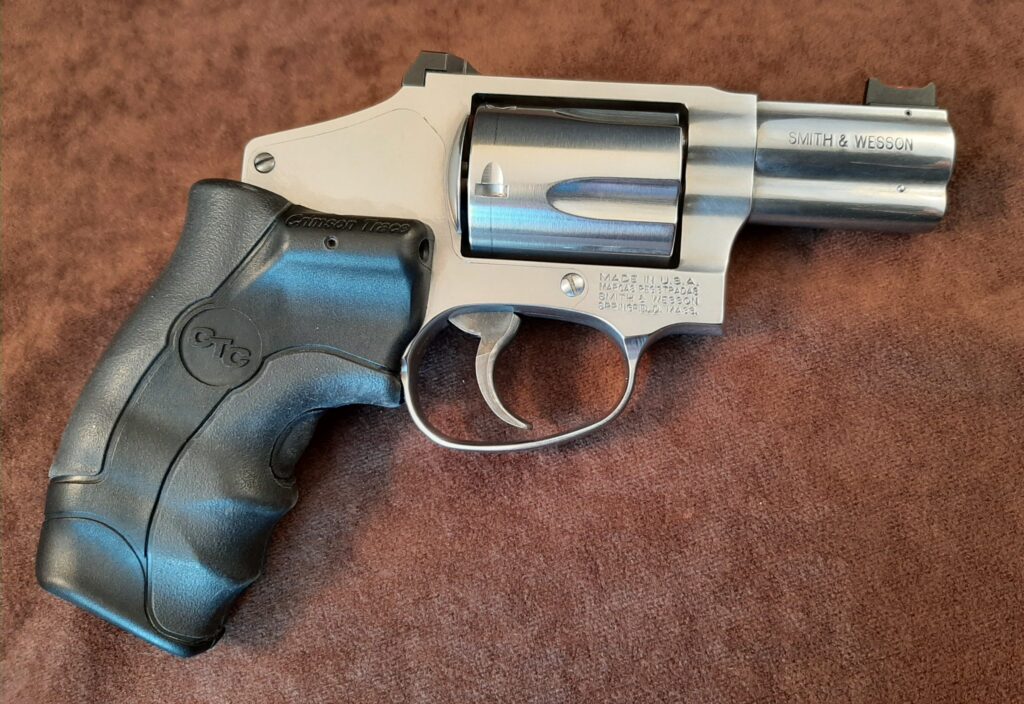
I cashed in some hoarded Cabela’s gift cards and ordered some. They’re a little shorter than the factory stocks and don’t add any weight (the 640 weighs 23.2 ounces w/ factory stocks, 22.9 ounces with the LG350’s). The pressure pad is nestled in the top finger groove and is less pronounced than on the LG405. It’s harder to engage, but a conscious squeeze of the middle finger will activate them. The green laser worked as advertised, visible on an overcast day. The LG350 fits my hand well and assists wonderfully (Ayoob was right) in recoil mediation.
Sights
The CT Laser Grips were a good add but couldn’t make up for the 640’s sights in all conditions. The sights slowed me down when shooting rapid fire drills- the shallow rear notch and short front sight were a vexing combination. I had tested D&L Sports’ excellent fixed revolver sights on an N frame recently and was sold on their functionality. Dave Lauck started making them because he got tired of waiting for S&W to put decent sights on J frames. The 640 had proven itself worthy, so off to Arizona it went. Dave machined the frame for his rear sight and mounted a tall square front post with a red fiber optic tube. He zeroed the gun and had it back to me swiftly.
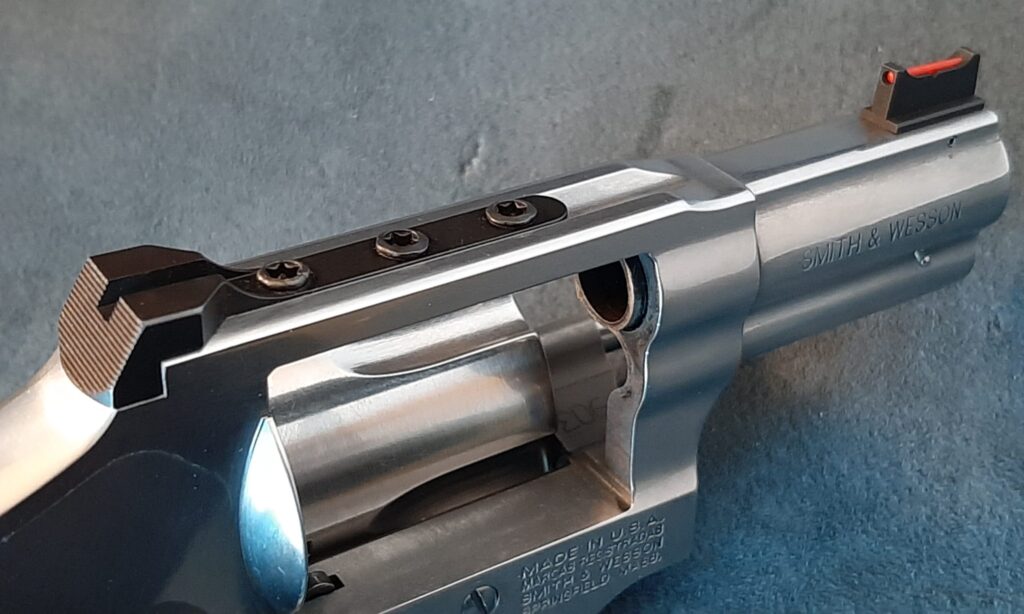
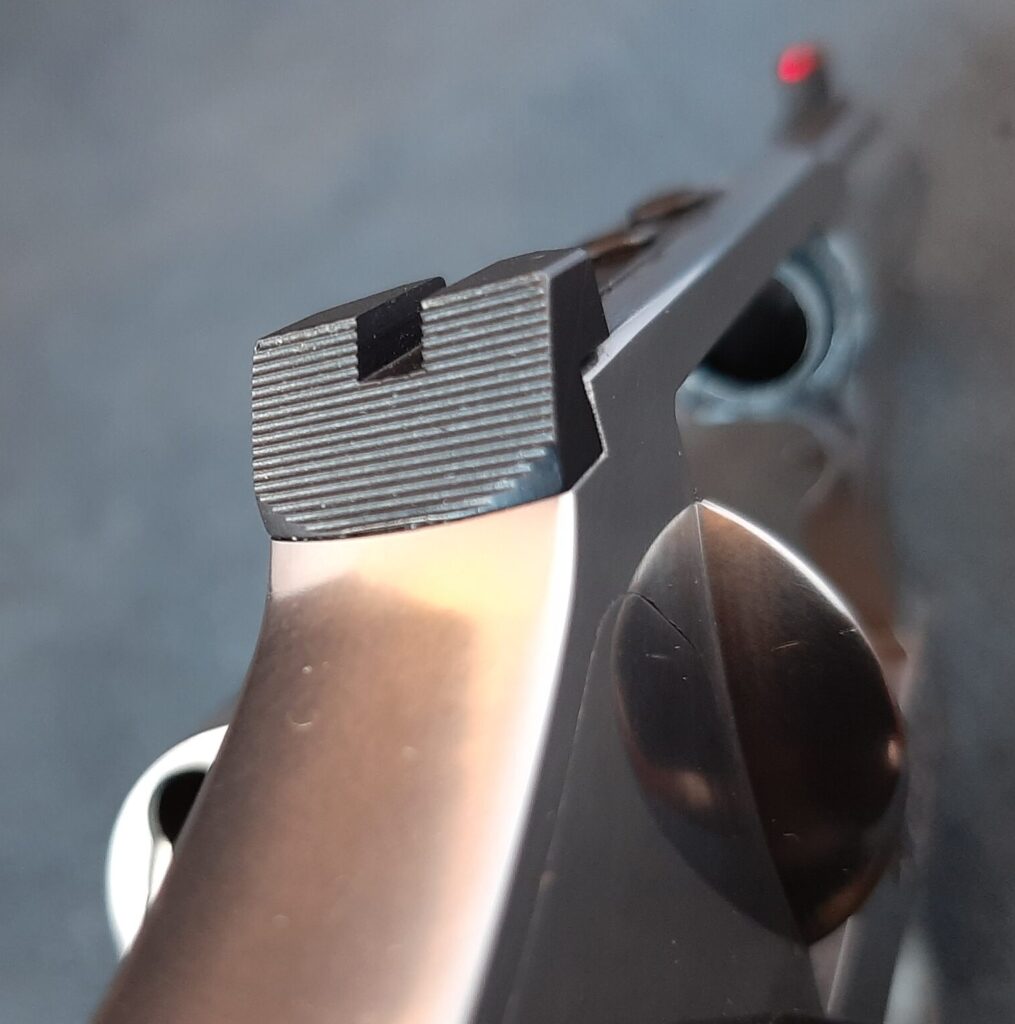
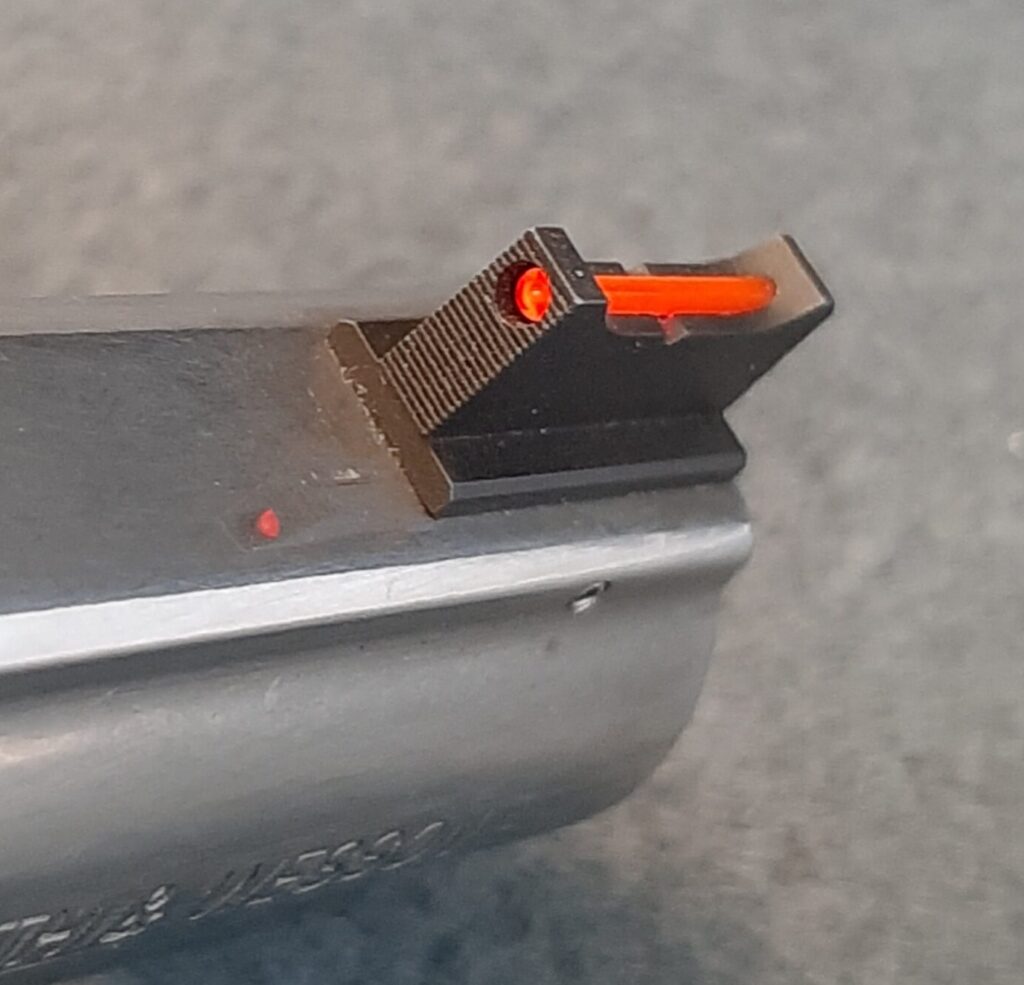
These sights come close to perfect for this gun’s mission. They’re tough fixed sights befitting of a carry gun that provide a great sight picture. All J frames should have sights like these! The factory sights were likely factory regulated with 158 grain bullets, but 115 and 124 grain 9mm bullets gratuitously impacted to point of aim at 3-15 yards. 135’s and 147’s struck a little high. This trend continued with the new sights, but it was much easier to put hits on target with them. On a side note, the 640’s yoke screw was a bit boogered when it journeyed to Lauck. When the gun returned, the screwhead had been cleaned up and looked brand new. That’s the kind of guy that Dave Lauck is.
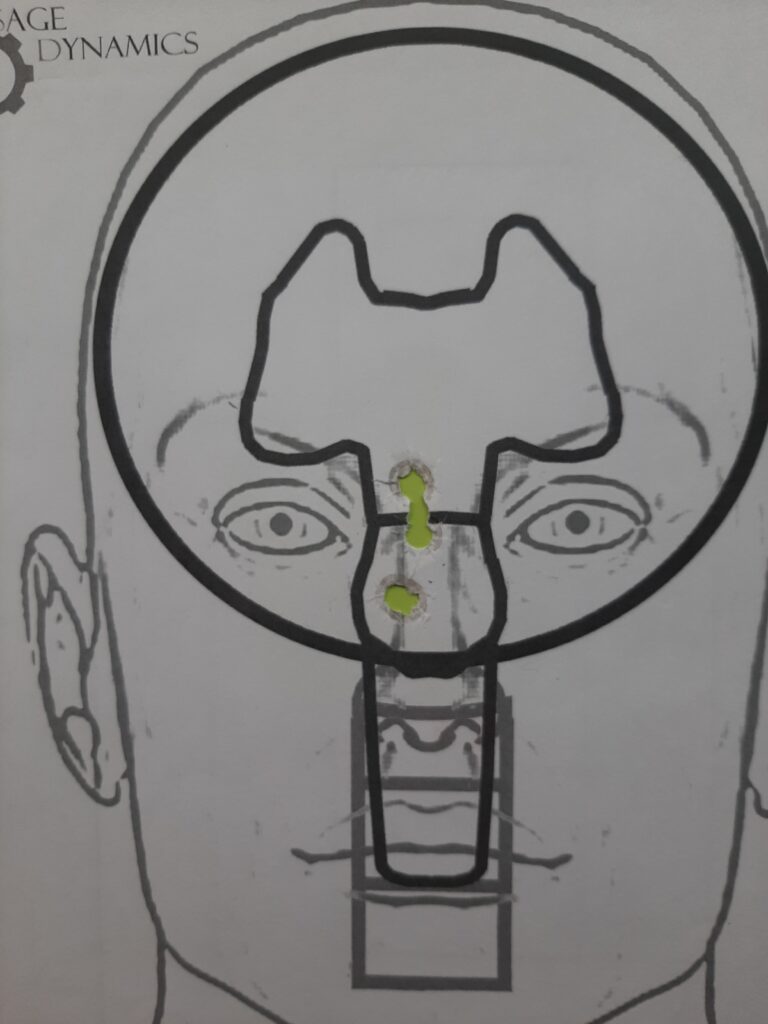
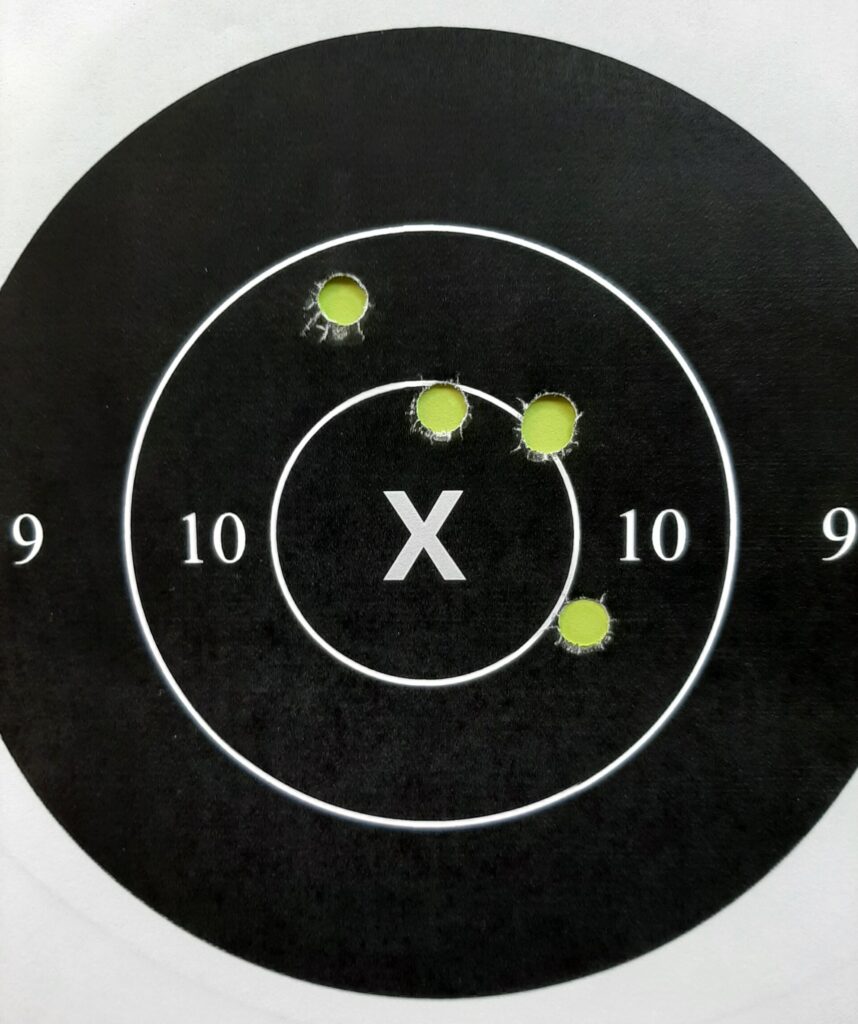
Packing it
The 640 was a little too big for pocket carry and too heavy for an ankle holster. It was going to be a waistband gun and the holster was an easy decision. I’d been using a Phlster City Special AIWB rig for a Ruger LCR with complete satisfaction. The sight track looked like it would clear the tall front sight Dave had installed. An email to Phlster confirmed that and the order was placed. Upon its arrival, I installed the longer “cleat” onto the mod-wing to better push the grip against my body. It worked like a charm- even with the larger grips the gun hides well and rides comfortably and securely.
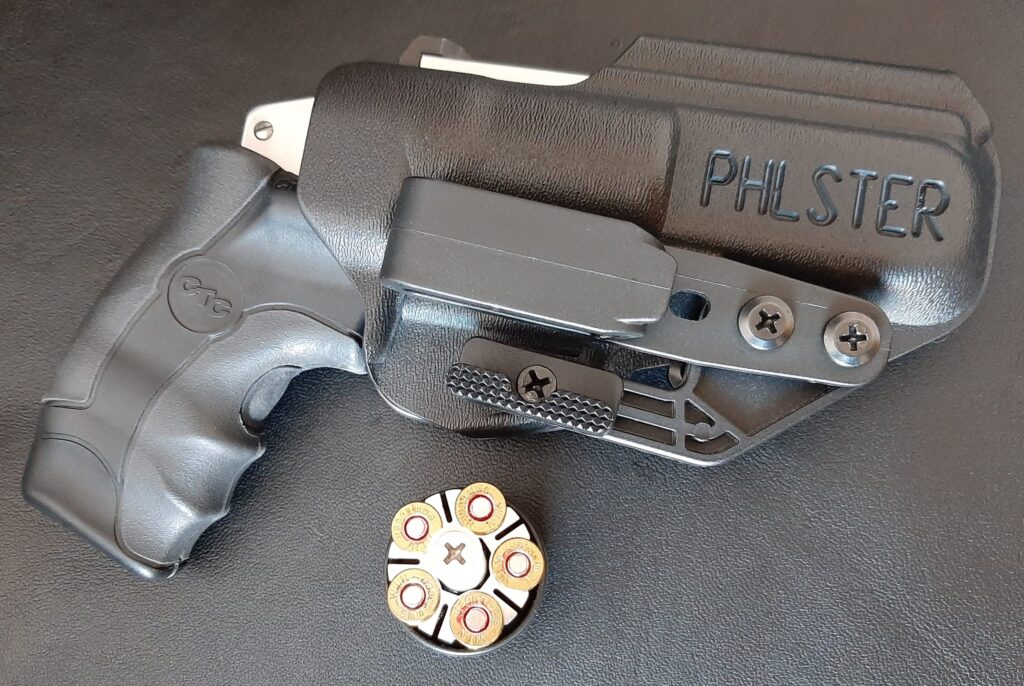
TK Custom sells a moon clip holder designed for concealed carry that looked like it would protect the clip and still be accessible. I ordered one and was pleased to see the name “Del Fatti” on the packaging when it arrived. It carries well in a jacket pocket, holds the clip securely and prevents bending or damage. Adding the moonclip to my EDC load out of a 2X2X2 pouch and a 4 round speed strip made carrying 15 extra rounds painless.
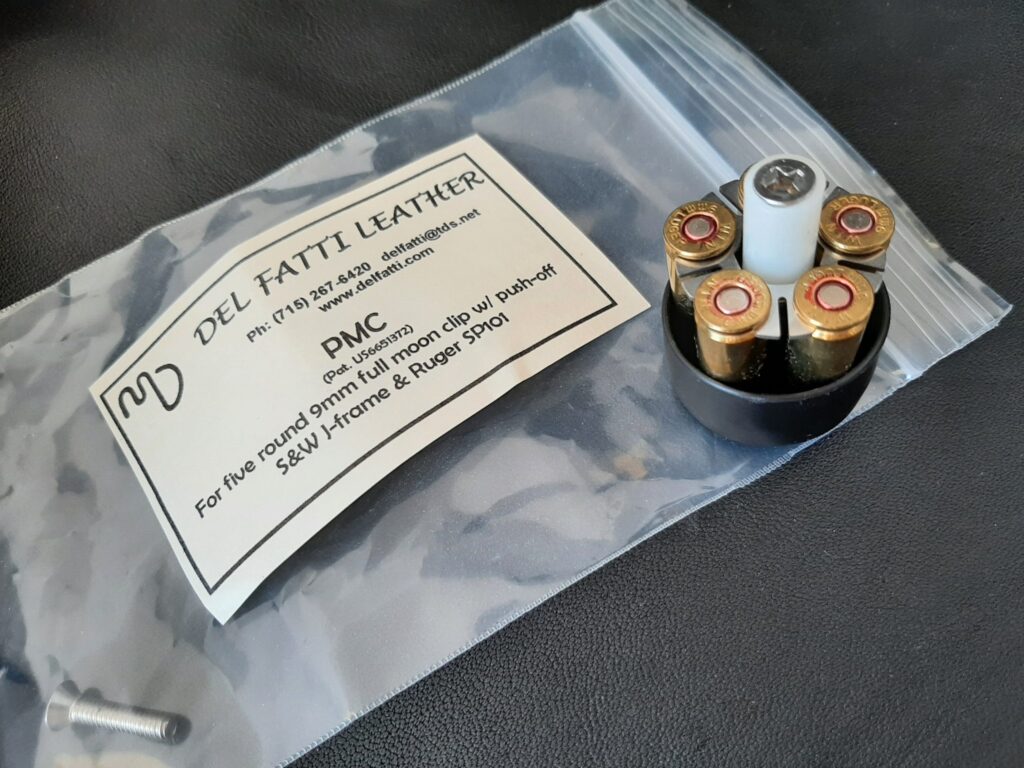
unlocking its potential
The only thing that wasn’t right about the 640 was the internal lock. Eli came to my rescue and sent one of TK Custom’s replacement plug kits. The kit consists of a plug and a retainer; After watching the short YouTube video, installation was easy and took about 10 minutes. The plug fits like a factory part and provides peace of mind against the lock breaking or malfunctioning. I messed up and ordered the matte finish instead of the polished, so it doesn’t quite match– but I like the way it looks. It draws attention to the gun’s “lack of lock”.
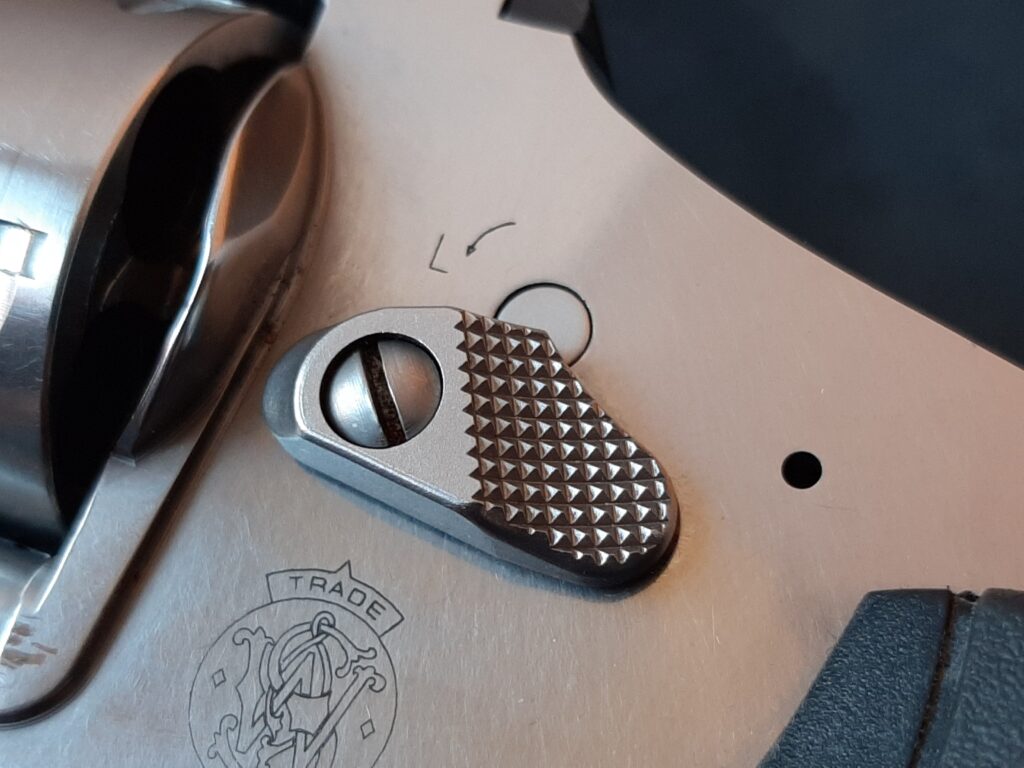
Success story
The rechamber has added to the ballistic efficiency and versatility of this little gun. It required some trial and error to guarantee function and maximize performance, but it was time well spent– a bullet nerd’s vision quest!
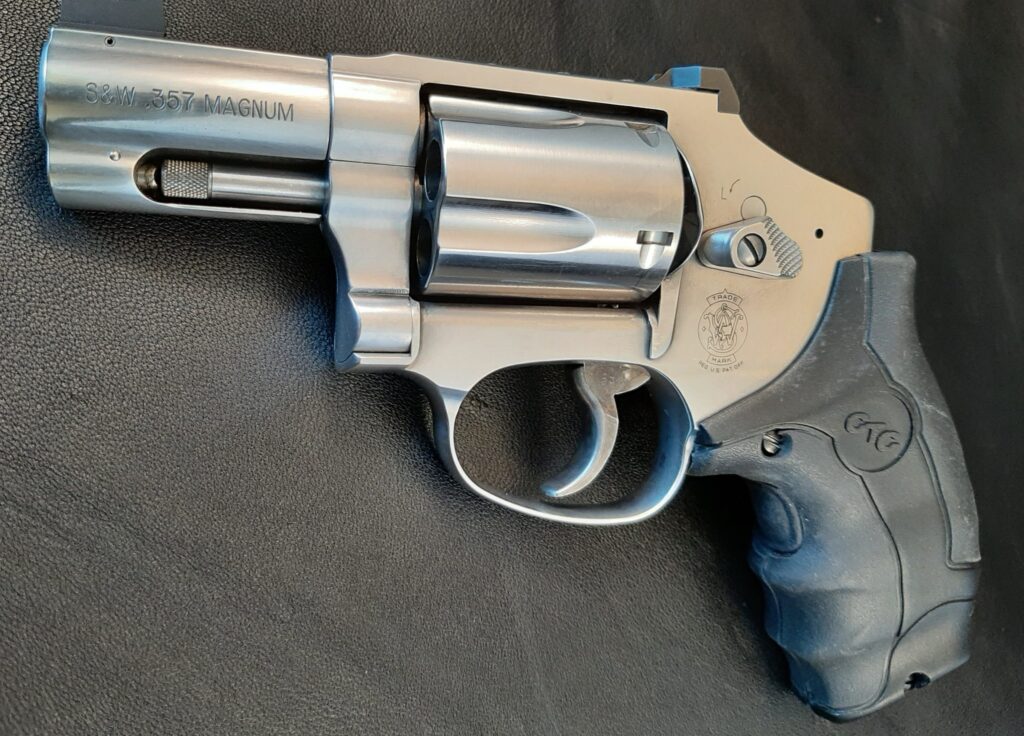
The few issues experienced taught me to buy ammo in small quantities until it was proven. With ammo it likes, moon-clipped empties fall out of the gun when inverted. The charge hole chamfer makes a big difference in the speed and ease of loading .38’s/.357’s back into the gun.
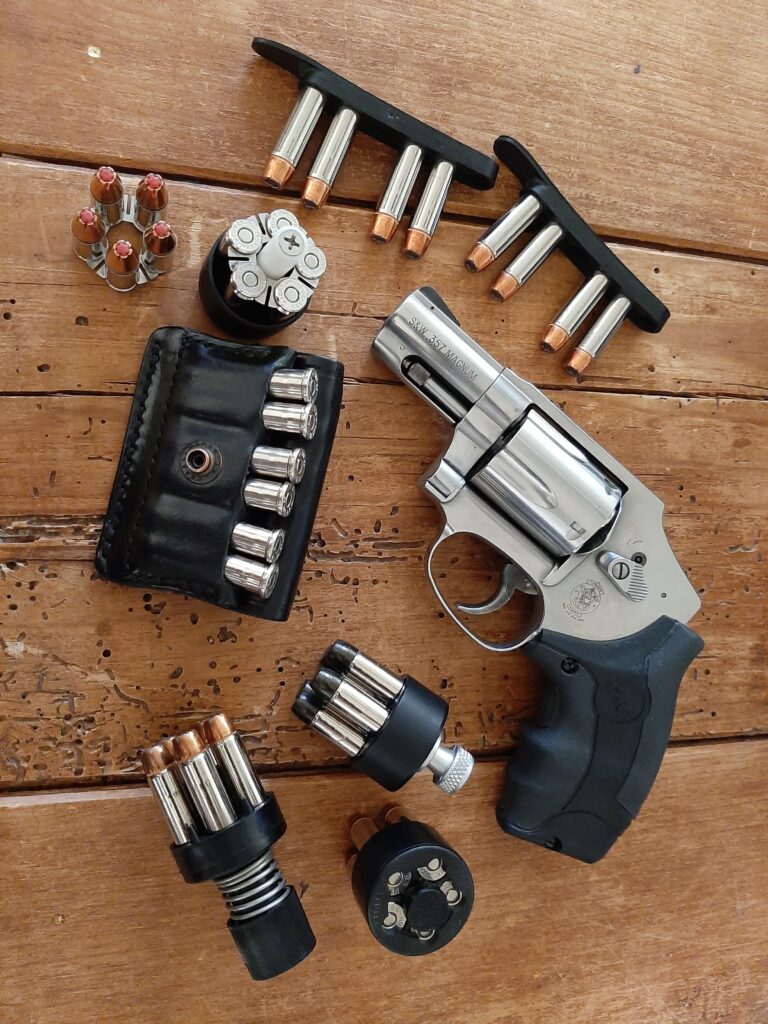
It’s been dry fired and shot so much that the factory trigger is now acceptably smooth. I couldn’t be more pleased with the sights on this gun, and the laser grips finish it. TK Custom and D&L Sports upgraded this revolver from Plain Jane to “Custom 640/940 Pro Series” and the pride of ownership is difficult to quantify. It’s gone from “most likely to be traded” to “most carried” status. Not sure I can give it any higher praise than that.

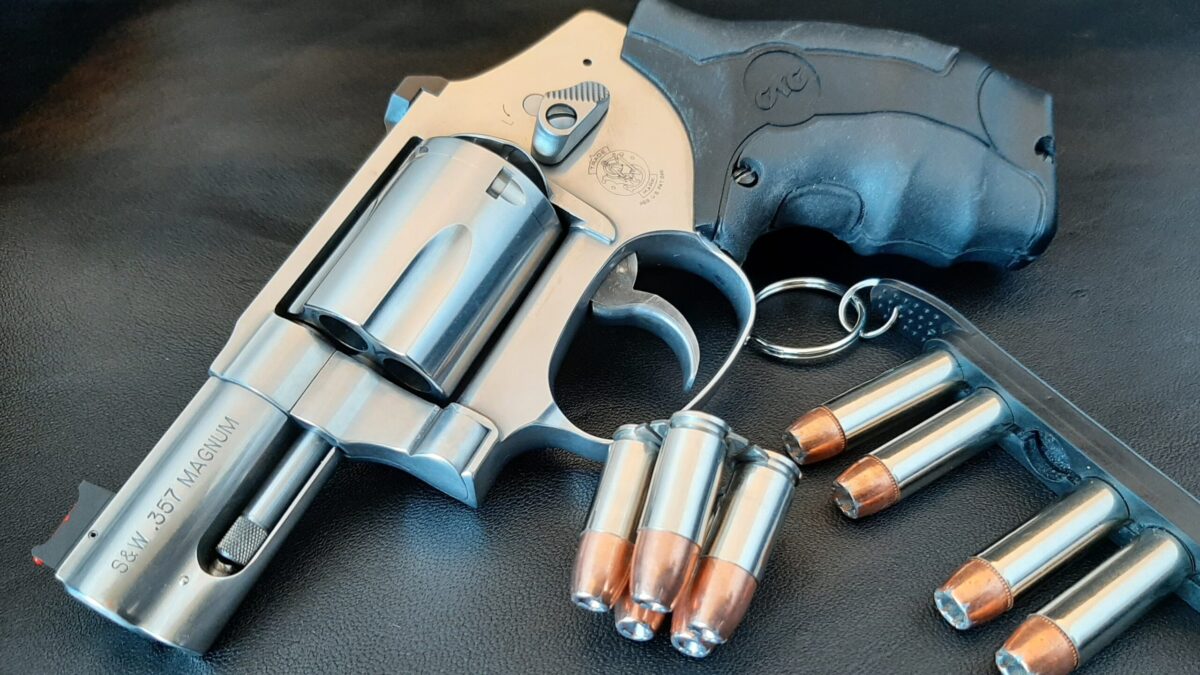
As much as I enjoy my semi autos, the only handgun I carry is a Smith J frame 640. While it’s not tricked out nicely like the author’s, it’s totally reliable, or as reliable as a handgun can be. My semi autos–not so.
Spencer,
Your comment struck me as particularly powerful. “it’s totally reliable, or as reliable as a handgun can be.” Well spoken, Sir.
That’s fascinating, thank you for the write up! I have (or had- we’ll see when the dust settles) a similar beast from the late ‘90s with a three inch barrel and target sights, which I’d love to custom up like that… I have to ask, could one use moon clips with .38 or .357 in this weapon as well? Thanks again for taking the time to write about this.
You’re welcome, Riley! I enjoyed every minute of it. Yes, when TK Custom finishes the conversion, that’s one of the benefits- it will work with moon clips for .38/.357 also. I apologize for not making that clear.
Thanks for sharing this excellent side project with us but I gotta ask; how much did all of the extra work cost on top of the initial purchase? It’s great you’re happy with the end result but with the rechambering, upgraded sights, laser grip, lock delete, and moon clip holster it couldn’t have been cheap. A lot of money spent for only a five round capacity is certainly a passion project reserved only for the most hardcore revolver fans (which you clearly are).
Thanks for writing, Jeb. There’s no doubt that the custom work was expensive, but I wouldn’t use the gun’s capacity as a yardstick to measure whether or not the expense was reasonable. If you decide that a 5-shot, small frame revolver is the best tool for your specific need, and you’re willing to spend some extra money to optimize it for the job, I think that’s a good call. One could easily take the opposite approach and argue that “only” having five shots is a great reason to make sure the gun is worked over, to ensure you can get the most out of each one.
I think this custom snub would be hard to beat for the mission Kevin uses it for. I know he has other guns, with greater capacities, that he can carry when it’s appropriate. But if you need a snub . . .
Hey Jeb, you’re welcome. You are correct, it wasn’t cheap and a “passion project for a hardcore revolver fan” is accurate. I am that, and I’m well pleased with the end result of the investment. You could buy a quality semi auto nicely equipped with triple the capacity for what I now have in this 640! When I committed to the rechambering, I decided to go all in. Mike does a good job describing my thought process in that, if it only holds five, I want it to be the best it can be. I like to carry small revolvers that hold six, but the end result of this project made me comfortable with five. It’s pretty capable for what it is. Any of the upgrades I have done will make your J frame better, you don’t have to jump off the cliff like I did! 🙂
Kevin thank you for the excellent article on getting a new carry gun and making it your own, sights, grips, holsters, best loads and accessories like speedloaders..
The same road we all need to walk down when we have selected a new firearm to serve as protection for self and others.
One of these days maybe we will get to punch holes in paper. I know I would benefit from your knowledge and experience.
My pleasure, Tony. Thanks for reading it! It was educational and I now have a great deal of pride of ownership in this little revolver. I can recommend TK Custom and D&L Sports wholeheartedly; they put magic in this J frame! I hope we get to do that someday, my friend. I would also benefit from your knowledge and experience. Obliged!
I sent my 640 off to Eli last year for his “basic” trigger job and I think the name is very deceptive. Not only did it come back with an 8.5lb DA trigger that cracks all primers, Eli also chamfered the charge holes. It took my 640 from a gun I shot reluctantly to one I’m excited to take to the range.
Hey Jeremy, Eli has a way with 640’s! Amazing how guys like him can convert reluctance to excitement, huh? I applaud your choices; I’m sold on chamfering charge holes- good medicine…
I like what you did with the sights too! I didn’t go that route but I opted for an XS dot (the standard size, not the big one) and it’s a big improvement over the factory serrated ramp. That might be a more accessible option for folks who are not yet ready to send their gun off to get milled.
Thank you! I think that my eyes are getting too old for iron sights until I shoot a revolver in the sunlight with Dave Lauck’s sights. His give me hope! As you point out, XS sights are beneficial, too. Every little bit helps on a J frame!
Fantastic article. Very well done
Thank you, Anner! It kind of flows easier when you have good content to write about. I’m proud to brag on the work that TK Custom and D&L Sports do.
Kevin, that is one sweet gun for sure !! My problem would be that I wouldn’t want to carry it – but that’s my hangup. One can only wonder whether we’ll ever see something from the S&W Performance Center like your 640 . . . .38, .357, 9m/m, all in one gun. Sort of the ultimate multi caliber revolver. ( hint, hint, nudge, nudge, a wink is as good as a nod, S&W )
Thank you, Sir! This one was built to carry, and I do so often! That would be pretty neat to see a factory version. If they want to start with a scandium framed 3-inch K frame in .38 Special/.38 Super, that would be okay, too…
I think the Medusa was the closest thing we ever got to that.
Now THERE is a gun I hadn’t heard mentioned in a long time!
I carried a pre-lock 640 in the late 90’s early 2000’s and was quite happy with it. One thing I did note was the cylinder would start to bind on the cylinder pin after shooting an unremembered number of magnum rounds through it. It never locked up but the trigger pull became very heavy. Apparently combustion gases found their way in between the pin and the cylinder. So after a practice session I would always pull the yoke and cylinder off and clean them. Something to think about with all revolvers.
Hey Brett, You bring up a good point on a critical maintenance area on d/a revolvers, especially with high round counts and/or hot magnum ammo. The Yoke barrel (S&W parlance) needs to be clean and fouling free to insure smooth function. That may be an area we should cover in the future…
Thanks!
A revolver in 9mm Luger doesn’t appeal to me, personally…but I can definitely see the appeal in it from an ammunition availability + pricing perspective.
It’s almost criminal how much cheaper and more widely available 9mm is over .38 Special right now. The cheapest box of .38 FMJ I recently got was $23.95. I paid $13.95 for a box of 9mm FMJ, also from SGAmmo.
And .357 Magnum? Fuggedaboudit
Yes sir, 9mm is appealing right now if you actually want to shoot your snub guns with factory ammo. Locally, 9mm FMJ best price is 17.99 per 50 rd box. .38 Special is running 31.99 a box, and finding it is still iffy. I have been waiting for four years to find a box or two of Speer 135 gr .357 Short Barrel GDHP.
If you handloaded ammo and had a good supply of primers when COVID hit, you are looking pretty wise in the aftermath.
One of the great advantages of 9mm in a snubby is their bullets are engineered to work in short barrels. Your average 38 is built for a cylinder + 4” barrel whis is about 5 1/2”. A snub cylinder + 2” is about 3 1/2” which is perfect for 9mm HP ammo
The efficiency of the short 9mm case and SAAMI pressure ceiling certainly help the 9mm to outshine the .38 Special in short barreled revolvers, too. The 9mm gets to take advantage of more “freebore” in the same length cylinder than the .38, too. Something to be said for the 9mm there…
Darn. I thought you’d be so fed up by the end you’d be vulnerable and I could talk you out of it, ha ha.
I saw two of these at a gun show last week—used—$800 each! I can’t believe I’m saying this but I could get a better deal on Gun Broker.
If I didn’t already have a 442 and an M60 I might get the 640. As it stands it would only fill a very small niche and I could spend that money practicing.
Good article, but I’m a little surprised you didn’t shoot wadcutters in it.
Hey Taylor, sorry I can’t help you there! Wow, 800.00 for a used 640? yeah, bring on Gun Broker! I saw a new one in a LGS recently for less than that.
I would agree you’re wise to spend money shooting the good ones you already have.
I did shoot wadcutters in it and it shot them very well. The 640’s weight is sufficient to make shooting lighter-weight .38 +P & 9mm JHP’s manageable; so I went that route. Those would be no fun in a 442 but are comfortable in the all steel 640. I’m saving my GA Wadcutters for my 442 or .38 LCR! Thanks.
I see that the 38/357 casings rest on the outer edge of the cylinder and maybe on a fraction of the star in the middle. The 357 rim is not fully supported by the cylinder around the entire circumference of the rim.
while this seems to be innovative, I could see issues with packing and shooting both types of ammo intermittently, especially in a rush firefight situation. I applaud the revolver that utilizes 9mm and 38’s without huge modifications in the field, i.e. changing a cylinder.
thanks
Hey Todd,
One of the biggest advantages to this system for me is the moonclipped 9mm’s in the gun for carry. if a reload is required, the moonclipped empties are coming out with the least likelihood of problems. I carry .38’s in a 2X2 pouch and a speedstrip w/4 .38’s to reload with. if the weahter is such that I can wear a hoodie or jacket, the Del Fatti pouch with a moonclip of 9mm goes in the pocket. They have all been quick and sure to reload, and I’m pleased with the set up for most places I go. It’s very nice to feed the 640 a varied caliber diet without having to change the cylinder, as you point out. Thanks!
Thanks for a thorough and detailed write up, Kevin…You’ve got Yourself a ‘one of a kind’, and she’s a beauty. I’ve added Dave’s sights to my 69 Combat along with a lock delete, and his sights are one of the best investments I’ve found. You’ve documented the effort it can take to make any revolver a good ‘fit’ for our unique needs, and it looks like it will be worth the effort. Looking forward to Your next installment!…
Kevin Massey
You’re welcome, Kevin. Thank you- this one turned out pretty good! That 69 of yours also sounds like a fine example of taking the steps to make a good one great. Your five shooter with Dave’s excellent sights might fill the role of “the right choice” better than mine in more rural zip codes. I like it! Thanks again and keep your powder dry down there…
Kevin:
I enjoyed your article about the J Frame. I don’t own a 640, but I carried a model 36 S&W with a 2″ barrel as a back up gun when I was active as an LAPD Police Officer. The gun was given to me by my brother, also an LA Cop, upon my graduation from the academy in 1971. I carried it in a leather rear pocket. It was loaded with the authorized department .38 caliber ammo of the day. Sometimes this ammo was anemic with 158 grain round nose lead bullets. In later times it was much better 125 grain jacketed hollow points at a decent velocity. I tried to shoot it frequently, but never tried it on the qualification course. I found it accurate enough for close range defense. The steel frame made it controllable enough for my confidence.
When I retired I planned to do some back packing. I saw a J Frame in our academy gun store that was made of Scandium. A very light weight material. I don’t recall the model number, but it was in .357 Magnum caliber. I thought what a perfect gun for back packing, light weight but with substantial power. I bought it, but had reservations about such a light gun firing .357 Magnum rounds. On a camping trip in the Eastern Sierras I tried it out with factory .357 loads. I believe they were 125 grain Remingtons. The gun handled five rounds well, accuracy was acceptable, but my hand throbbed like a bad headache for a half hour. This J Frame would be good for the purpose I had in mind, but much better with .38 +P loads than full house .357’s. A reminder that there is “no free lunch.” A decrease in weight or an increase in power comes with a cost.
My hand aches, just thinking about it, Sir!
I’ve drawn a personal line in the sand, and restrict .357s to steel frame guns—preferably K or larger, with hand-filling grips.
Thank you D+B. You are right to remind everybody that there is no free lunch when it comes to balancing weight, caliber, and power levels in small guns. That 125 grain Remington .357 load was a handful in a steel K frame Combat Magnum. I think Clint Smith referred to them as “blue flamers”. I have recorded velocities of 1470+fps from 3″ guns with that load. I have no interest in shooting them through ANY J frame.
I recall helping teach a revolver portion of a police firearms instructor class in Colorado several years ago. I had opened the range to allow students to fire each other’s guns to familiarize with different revolvers. One chap had a lightweight J frame and encouraged a female student to fire it with the magnum rounds he had loaded in it. I didn’t see the event, but based on the after action report: she gamely fired one round. She went to hand it back and was encouraged to finish the cylinder. Not wanting to lose face, she did so. her grip was violently displaced with each shot; the last shot she fired split the skin at the web of her thumb bad enough to mandate a trip to the ER for stitches. I doubt that experience won her over as a revolver fan. The power to weight ratio definitely comes at a price…
Ugh. I hope the guy who set her up was appropriately dealt with. What a stupid thing to do. I bet you were REALLY mad when you found out!
I was not involved in the department’s handling of the incident, but I know that group of guys handled it appropriately. You are correct, I was pretty upset. I don’t think the officer meant her harm, but it was a senseless, avoidable injury- and one that we can all work at never allowing to happen again.
I have had the pleasure over the years to introduce several new shooters to handguns. Many of these new shooters were women who had never fired a gun. Often they turned out to be excellent shots because they had not developed bad shooting habits to overcome. I also saw on several occasions that male police officers would take their wives or girl friends to the range ostensibly to teach them to shoot. The male officer would introduce the lady to shooting by having her fire a high power magnum handgun. I think these guys were trying to impress the ladies with their macho manhood. Of course after this experience these women were very recoil shy and in many cases would not shoot a handgun again. This always made me angry. We don’t need to make antigun advocates out of anyone, especially women. Better to start out with gentle recoil like a .22 RF or at most a .38 Wadcutter target load. Let’s keep our ladies on our side in the gun argument.
D+B, you are spot on. This comes up every so often, and I hope that us talking about it will be a reminder. We only get one chance to make a good first impression with a new shooter. A positive outcome in one of those encounters is so critical to putting them on the right path. That’s a pretty good justification to own a .22 RF or a full size revolver with a good trigger that makes shooting wadcutters easy and pleasant. Good guns to win the hearts and minds of the people!
The small increase in velocity from .357 Magnum rounds out of a two-incher J-frame Smith won’t override their punishing recoil and lesser accuracy, in this old dude’s view. Relatively low recoil, more accurate, and easy-on-the-hand wadcutters for my snubby!
Old dudes know stuff, Spencer. That’s how they got to be old dudes! Your wisdom makes a great case for wadcutters in a lot of these guns.
Thank you for a great article. Five years ago, I bought a Smith & Wesson M360. It is a scandium frame, Jframe with a steel cylinder. I sent it off to TK custom (Eli). After a trigger job, nine mil conversion, big dot sight. I added a bobbed hammer. I also purchased an unmodified titanium cylinder and crane. I have the crimson trace red laser grips. The steel cylinder ejects 38 special in 357 magnum without moon clips as well as any JFrame. It is very versatile. With one screw, I can swap cylinders. I still can’t decide to carry it with the steel cylinder in the 9mm, or the titanium with 357 Magnum. Regardless, when shooting the steel cylinder, I prefer the 9mm over stuffing that steel cylinder with 38 or 357 magnum. The gun shoots better and smoother with 9 mm. And with 9mm, it’s less likely I have to visit an orthopedic surgeon. And I agree with the author. This is now my most likely to carry gun.
Thanks Brett, glad you enjoyed it. Eli does great work on these guns!
A scandium frame with a titanium cylinder stuffed with .357 Mag? I’ll take a HARD PASS on that one! Give me the 9mm in the steel cylinder, instead (or better yet, the .38 Spl in the steel cylinder)!
Interesting upgrades, how would you compare your gun versus the factory 640 Pro?
I absolutely love the one I have, came factory with tritium 3 dot sights, no internal lock, and cut for moon clips.
Hey John, the 640 Pro is an outstanding choice for a carry gun. As you point out, it is exceptionally well featured as it comes from the factory. The only concrete advantage mine would give would be the ability to chamber 9mm ammo, if that is a need. Everything else is subjective. I’m a believer in Dave Lauck’s great sights, and I like the comfort provided by these big CT Laser grips when shooting magnum ammo. That said, the 640 is very well featured at a significantly lower cost than the one I built. You are well heeled!
Mr. McPherson,
Great article on a nice Md 640. I’m glad you project turned out so well, rendering a more capable companion. I’ve enjoyed S&W J-frames in all the iterations I’ve owned and fired and while not currently owning a 640, I do have it’s stable mate with a Md 649-3 that I acquired a couple decades earlier at an older Gander Mountain for the mid $200. range. And while it’s given me years of great service my now seven-decades old eyes could certainly benefit by the custom sights and CTC Laser grips. Given me another project to consider.
I’ enjoy owning a shorter barreled revolvers in 9mm, but just not my current 649 as it’s already earned it spurs with me as it’s currently chambered. I do already have a Md 642 for those times I feel the need to pocket carry (trousers or coat). Anytime I feel the need for “more gun” in a winter coat pocket, I can usually manage my Md 296 in .44 Special and CCI’s 200 grain GDHP’s.
But thank you again for a well written, informative article and thank you for your service as a LEO.
Yours respectfully, Dave.
Hey Sir, thank you for your kind words about my article- I’m glad you found it worth reading. That was a pretty good score you made at that old Gander Mountain! Dave Lauck’s excellent sights and the CT grips made hits easier for my advancing eyes, thumbs up from me if you go down that project path! You are well heeled, Sir. I have been pondering that whole .44 pocket gun thing of late. I don’t know that I’ll ever run across a Model 296, but I may see if I can find a Charter Bulldog to fool around with. It will also be loaded with 200 gr. GDHP’s if they hit close to the sights. If they don’t, I guess it’s time for another project! I was proud to serve, and I appreciate your thanks. Best to you!
Mr. McPherson,
I have been carrying a 640 Pro Series in a City Special for about 1.5 years now, and I bought one of the Del Fatti PMCs on your recommendation. I like everything about the entire system short of capacity of j-frames, but I find the syringe style release of the fresh clip from the PMC to be a bit slow and fiddly at times. To remedy this, I tied a length of tough, spectra string to the Chicago nut on the base and to my belt. Now, when I wish to retrieve a reload in a hurry, I simply grab the rounds and yank them out of my pocket. This solution is very fast and more consistent than the syringe method.
I took a series of pics of the setup. If you’re interested in seeing them, let me know.
Thanks for your blog. It has been very informative for me as I have begun using revolvers.
Sincerely,
John
Hey John, thanks for reading it- I’m with you on the capacity; only true bummer of these guns. Your idea with the spectra string is brilliant! I’m going to have to try it, I can see where it would remove the fumbling with it. Thanks for sharing it, and I’m glad you’re getting something from the blog- I learn stuff all the time from the guys that write here, too.